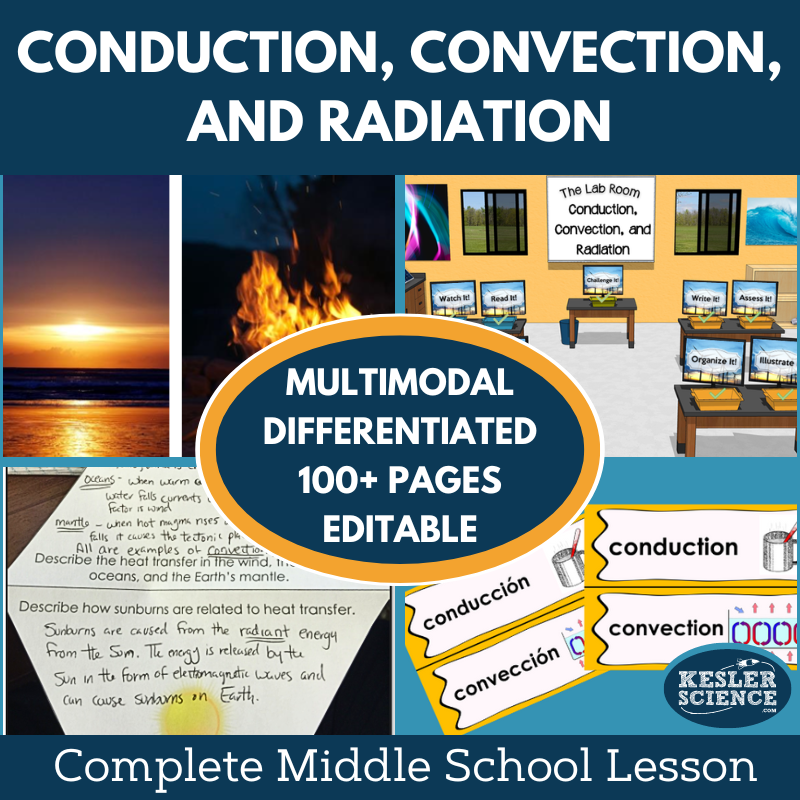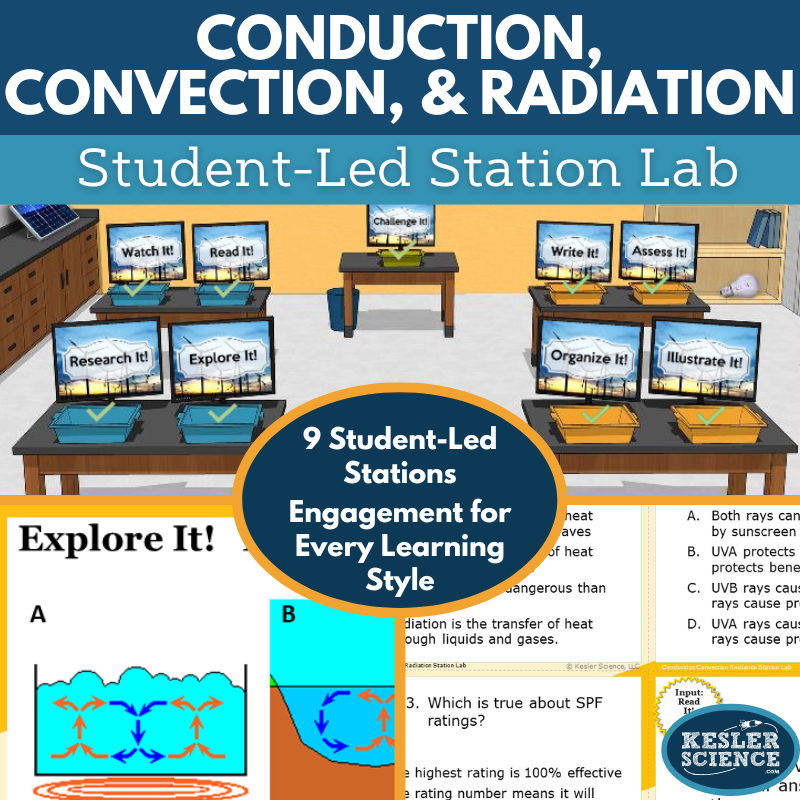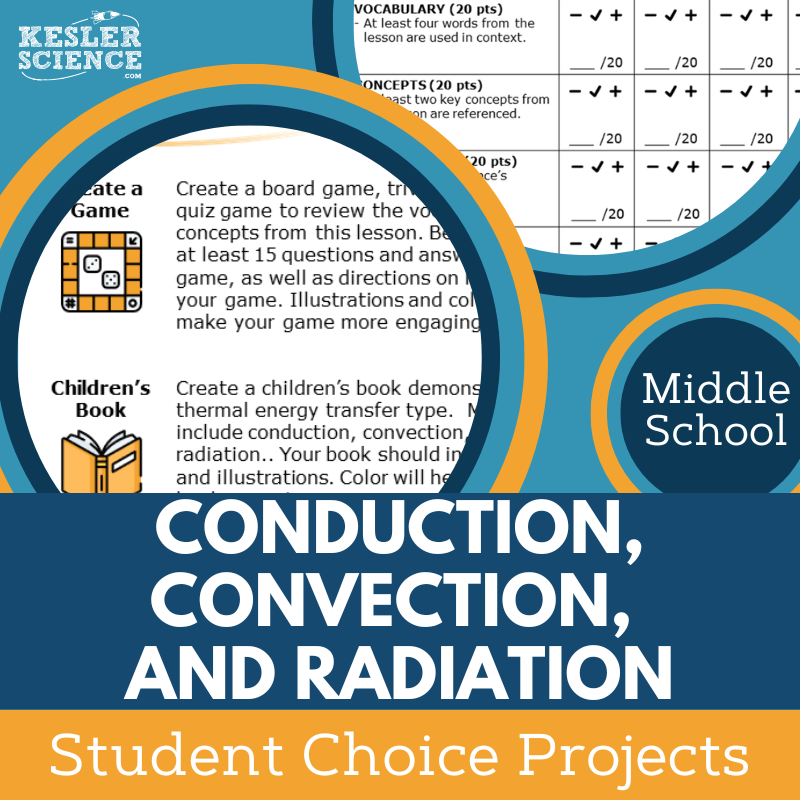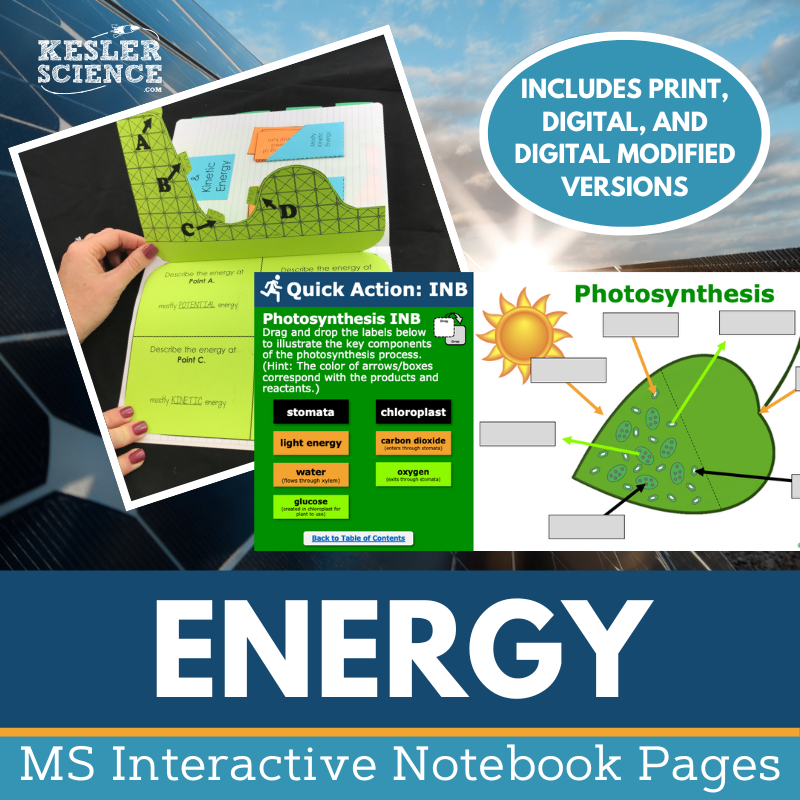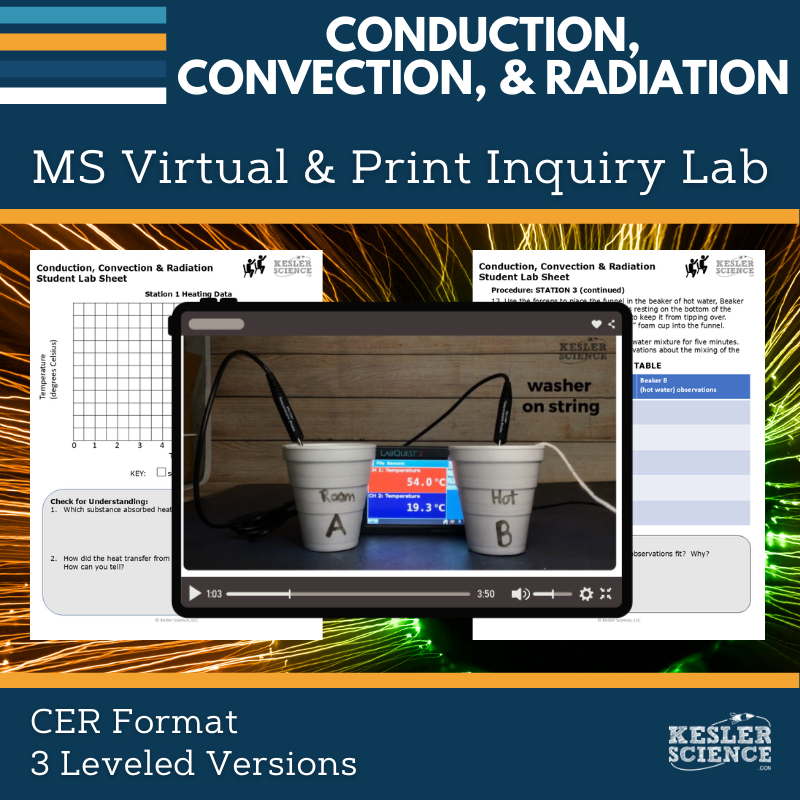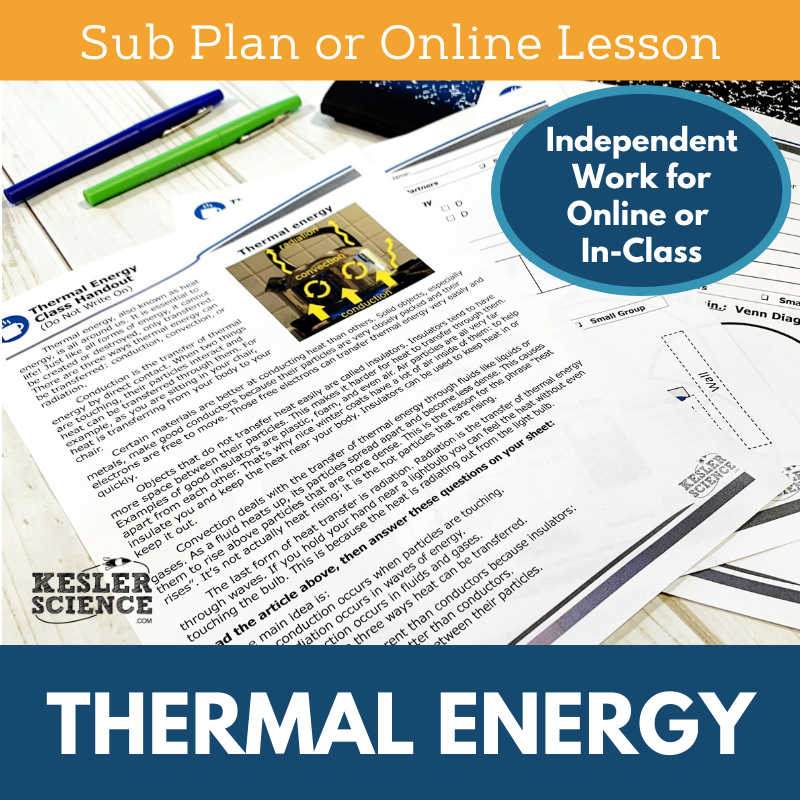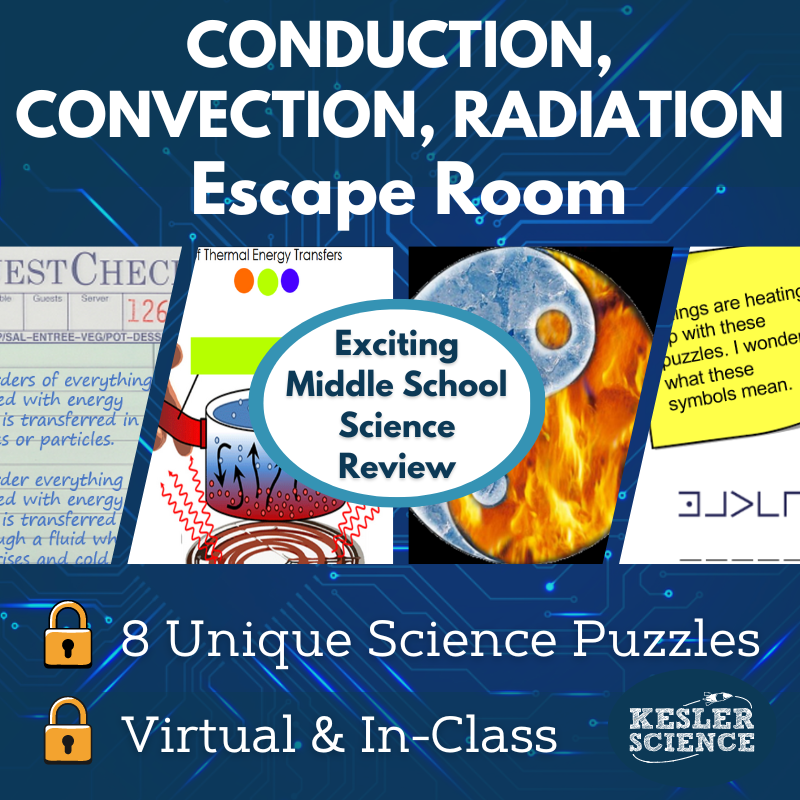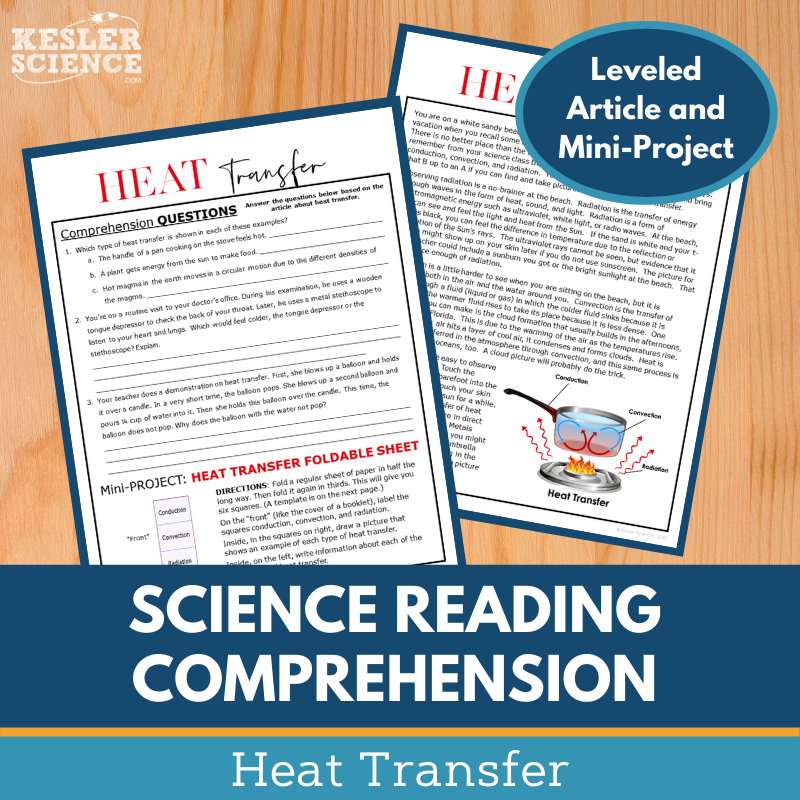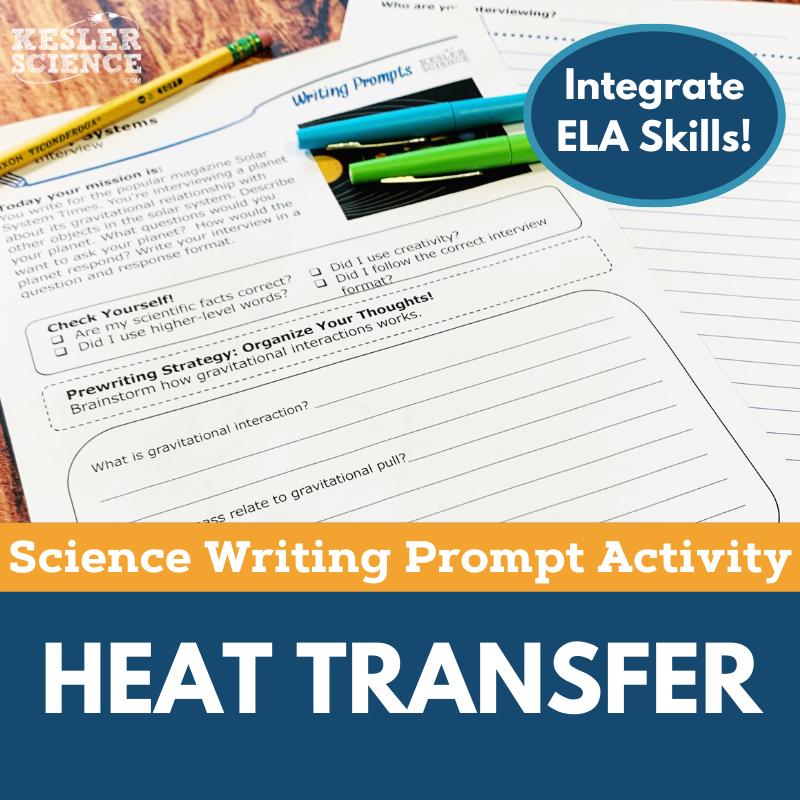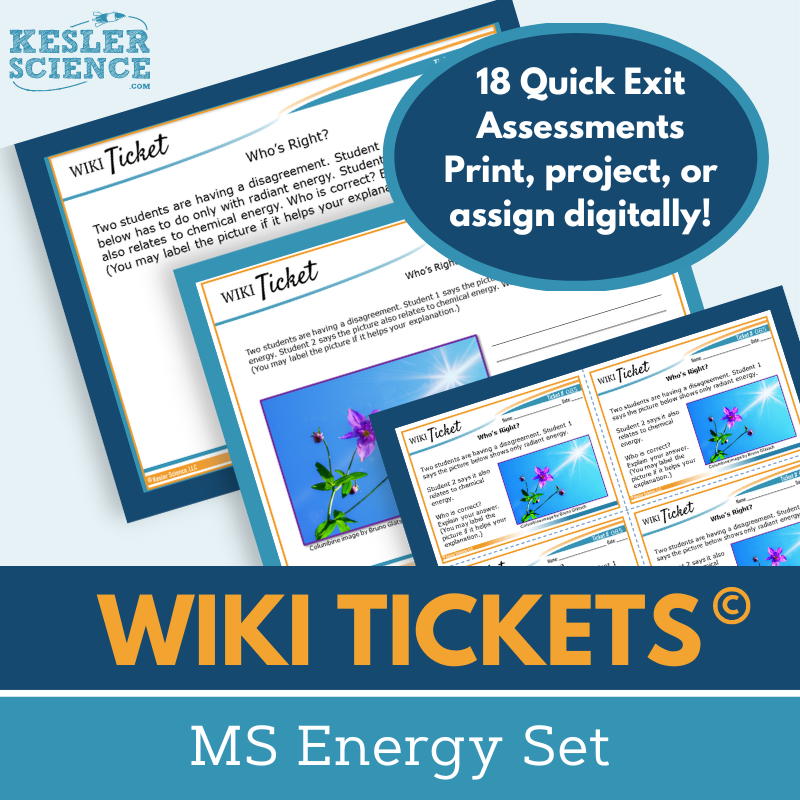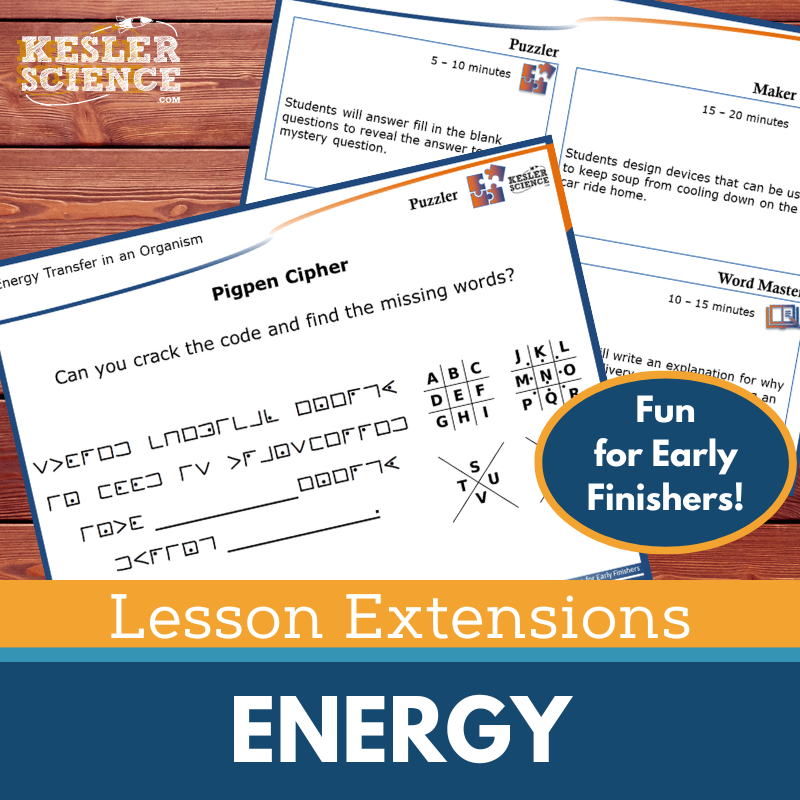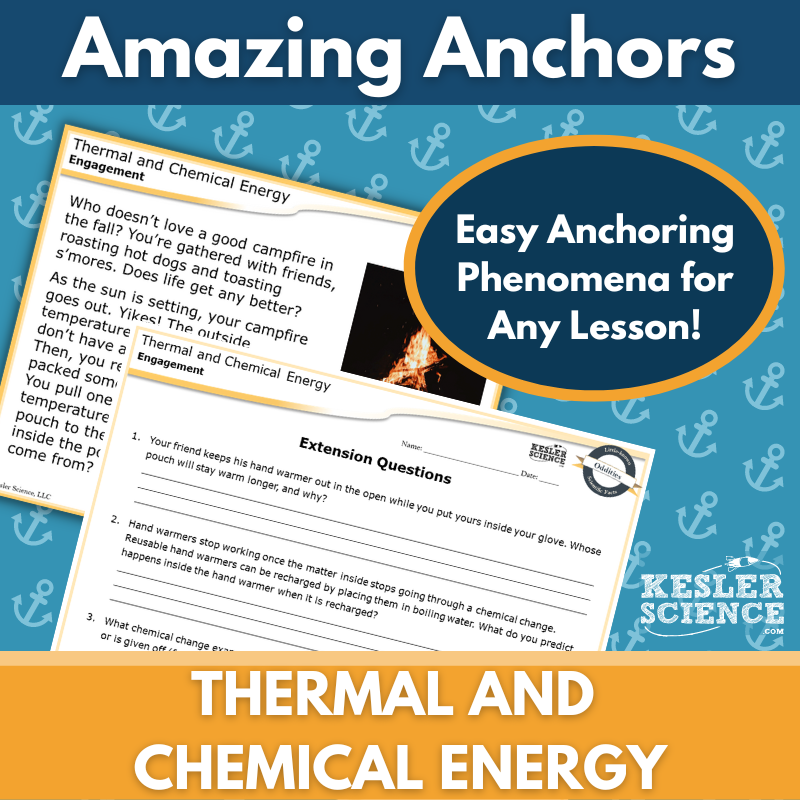Conduction, Convection, and Radiation Activities for Middle School Science
The Kesler Science Conduction, Convection, and Radiation resources offer a comprehensive, student-centered approach to understanding thermal energy through differentiated, multimodal activities. The resources below will give students a comprehensive understanding of conduction, convection, and radiation. All of the following materials are also included in the Kesler Science Membership.
The Kesler Science Conduction, Convection, and Radiation Complete 5E Lesson offers a flexible, student-led learning experience with minimal prep, enabling you to focus on student success. Junior high students will explore essential questions about thermal energy, and methods of demonstrating conduction, convection, and radiation through various activities.
Differentiated materials support all learners, and the lesson accommodates multiple formats—printable, digital, and editable PowerPoints. The lesson follows the 5E Model, including Engagement, Exploration, Explanation, Elaboration, and Evaluation stages. It provides diverse resources like word wall cards, class activities, and differentiated stations for learning. The stations cover input methods like experiments, reading, research, and videos, and output activities such as organizing, writing, and illustrating concepts.
Additionally, interactive notebooks, student-choice projects, and assessment options allow for tailored learning. Challenge activities for early finishers and various evaluation formats ensure all students are supported. The lesson is adaptable for both in-class and virtual settings.
The Kesler Science Conduction, Convection, and Radiation Complete 5E Lesson offers a flexible, student-led learning experience with minimal prep, enabling you to focus on student success. Junior high students will explore essential questions about thermal energy, and methods of demonstrating conduction, convection, and radiation through various activities.
Differentiated materials support all learners, and the lesson accommodates multiple formats—printable, digital, and editable PowerPoints. The lesson follows the 5E Model, including Engagement, Exploration, Explanation, Elaboration, and Evaluation stages. It provides diverse resources like word wall cards, class activities, and differentiated stations for learning. The stations cover input methods like experiments, reading, research, and videos, and output activities such as organizing, writing, and illustrating concepts.
Additionally, interactive notebooks, student-choice projects, and assessment options allow for tailored learning. Challenge activities for early finishers and various evaluation formats ensure all students are supported. The lesson is adaptable for both in-class and virtual settings.
The Kesler Science modular, student-led Conduction, Convection, and Radiation Station Lab is designed to keep middle school students engaged while learning about energy. It provides comprehensive materials that save prep time and promote self-directed learning. Through this lab, students create a model to predict and describe changes in particle motion, temperature, and state of pure substances.
The lab includes eight differentiated activities across nine stations, with a challenge station for early finishers. In this student-centered setup, the teacher guides learning rather than leads it. Students complete tasks independently or in small groups, with resources and signage provided. Some stations may require basic lab materials.
Stations are divided into input and output categories. Input stations introduce new concepts through hands-on activities, research, reading, and videos. Output stations allow students to demonstrate their learning through hands-on manipulatives, drawing models, writing responses, and answering task cards. The bonus Challenge It! station offers enrichment activities for advanced students. These stations work both in the classroom and virtually.
The Kesler Science modular, student-led Conduction, Convection, and Radiation Station Lab is designed to keep middle school students engaged while learning about energy. It provides comprehensive materials that save prep time and promote self-directed learning. Through this lab, students create a model to predict and describe changes in particle motion, temperature, and state of pure substances.
The lab includes eight differentiated activities across nine stations, with a challenge station for early finishers. In this student-centered setup, the teacher guides learning rather than leads it. Students complete tasks independently or in small groups, with resources and signage provided. Some stations may require basic lab materials.
Stations are divided into input and output categories. Input stations introduce new concepts through hands-on activities, research, reading, and videos. Output stations allow students to demonstrate their learning through hands-on manipulatives, drawing models, writing responses, and answering task cards. The bonus Challenge It! station offers enrichment activities for advanced students. These stations work both in the classroom and virtually.
The Kesler Science Conduction, Convection, and Radiation Student Choice Projects empower middle school students to demonstrate their learning in creative ways. Students select from nine project options, including a “design your own” choice, with a detailed project page and a flexible, editable rubric for teacher, peer, or self-assessment.
The projects are differentiated to meet diverse needs, with a modified version providing options for remediation and support. Advanced students can combine multiple projects for an added challenge, all while using the same rubric for consistency.
These student-led projects require common classroom supplies like paper, markers, and scissors, with options for digital submissions or hands-on crafting, making them both accessible and engaging for all learners.
The Kesler Science Conduction, Convection, and Radiation Student Choice Projects empower middle school students to demonstrate their learning in creative ways. Students select from nine project options, including a “design your own” choice, with a detailed project page and a flexible, editable rubric for teacher, peer, or self-assessment.
The projects are differentiated to meet diverse needs, with a modified version providing options for remediation and support. Advanced students can combine multiple projects for an added challenge, all while using the same rubric for consistency.
These student-led projects require common classroom supplies like paper, markers, and scissors, with options for digital submissions or hands-on crafting, making them both accessible and engaging for all learners.
The Kesler Science Energy Interactive Notebook Bundle offers an engaging way to teach energy concepts with both print and digital options. It’s perfect for traditional classrooms, 1:1 environments, or distance learning, providing flexibility for teachers and students alike.
Topics include conduction, convection, and radiation, energy transformations, renewable and nonrenewable resources, photosynthesis, potential and kinetic energy, and more. The digital version features a unique interactive notebook PowerPoint, compatibility with Google Slides, reflection pages, teacher answer keys, and a modified version for accommodations. The paper version includes blank templates, pre-filled templates for modified needs, and visual guides for assembly.
This bundle ensures students can actively participate in learning energy concepts while offering teachers versatile tools for instruction and assessment in any learning environment.
The Kesler Science Energy Interactive Notebook Bundle offers an engaging way to teach energy concepts with both print and digital options. It’s perfect for traditional classrooms, 1:1 environments, or distance learning, providing flexibility for teachers and students alike.
Topics include conduction, convection, and radiation, energy transformations, renewable and nonrenewable resources, photosynthesis, potential and kinetic energy, and more. The digital version features a unique interactive notebook PowerPoint, compatibility with Google Slides, reflection pages, teacher answer keys, and a modified version for accommodations. The paper version includes blank templates, pre-filled templates for modified needs, and visual guides for assembly.
This bundle ensures students can actively participate in learning energy concepts while offering teachers versatile tools for instruction and assessment in any learning environment.
The Kesler Science Conduction, Convection, and Radiation Inquiry Lab helps students explore the differences between conduction, convection, and radiation through engaging, interactive stations or a fully virtual lab experience. Both print and digital versions include comprehension questions, Claim-Evidence-Reasoning (C.E.R.) prompts, and reflection sections to guide student understanding. A pre-recorded video demonstration is also included in the digital version, allowing students to follow along with the procedure—even if they’re absent or without materials.
Each format includes three differentiated levels—dependent, modified, and independent—ensuring accessibility for all learners. The hands-on lab features stations with materials like sand, thermometers, washers, food coloring, and hot water to model each type of thermal energy transfer. The digital version requires no materials and includes interactive simulations, making it a flexible option for classrooms with varying needs.
Teachers receive editable files in multiple formats, answer keys, and comprehensive planning resources. With compatibility across platforms like Google Slides, MS Teams, and Schoology, this lab provides a versatile and engaging way for students to investigate how thermal energy moves through different mediums.
The Kesler Science Conduction, Convection, and Radiation Inquiry Lab helps students explore the differences between conduction, convection, and radiation through engaging, interactive stations or a fully virtual lab experience. Both print and digital versions include comprehension questions, Claim-Evidence-Reasoning (C.E.R.) prompts, and reflection sections to guide student understanding. A pre-recorded video demonstration is also included in the digital version, allowing students to follow along with the procedure—even if they’re absent or without materials.
Each format includes three differentiated levels—dependent, modified, and independent—ensuring accessibility for all learners. The hands-on lab features stations with materials like sand, thermometers, washers, food coloring, and hot water to model each type of thermal energy transfer. The digital version requires no materials and includes interactive simulations, making it a flexible option for classrooms with varying needs.
Teachers receive editable files in multiple formats, answer keys, and comprehensive planning resources. With compatibility across platforms like Google Slides, MS Teams, and Schoology, this lab provides a versatile and engaging way for students to investigate how thermal energy moves through different mediums.
The Kesler Science Thermal Energy Sub Plan guides students through a complete lesson, starting with a warm-up, followed by a reading passage, and an activity to classify images as conduction, convection, or radiation. Students then analyze a diagram and answer questions about conductors and insulators. Extensions for early finishers include creating a Venn diagram or designing a shelter to insulate penguins. The lesson concludes with an assessment or exit ticket.
This sub plan is designed to make your day out seamless with comprehensive substitute instructions, a student letter, behavior checkpoints, and answer keys. It includes engaging activities, a thorough lesson on thermal energy, extension options, and summative assessments. Digital versions feature a student-only PDF, editable documents, and a Google Form answer sheet, making it suitable for distance learning or classroom use.
Perfect for substitute days, remote learning, or additional assignments, the sub plan is student-centered and easy for substitutes to follow. It can also be used for ISS, homework, extra credit, or small group instruction, ensuring flexibility and academic continuity.
The Kesler Science Thermal Energy Sub Plan guides students through a complete lesson, starting with a warm-up, followed by a reading passage, and an activity to classify images as conduction, convection, or radiation. Students then analyze a diagram and answer questions about conductors and insulators. Extensions for early finishers include creating a Venn diagram or designing a shelter to insulate penguins. The lesson concludes with an assessment or exit ticket.
This sub plan is designed to make your day out seamless with comprehensive substitute instructions, a student letter, behavior checkpoints, and answer keys. It includes engaging activities, a thorough lesson on thermal energy, extension options, and summative assessments. Digital versions feature a student-only PDF, editable documents, and a Google Form answer sheet, making it suitable for distance learning or classroom use.
Perfect for substitute days, remote learning, or additional assignments, the sub plan is student-centered and easy for substitutes to follow. It can also be used for ISS, homework, extra credit, or small group instruction, ensuring flexibility and academic continuity.
The Kesler Science Conduction, Convection, Radiation Escape Room offers an engaging way for students to demonstrate their understanding of conduction, convection, and radiation. Teachers have full control over the eight independent puzzles, making it adaptable for various class lengths. Students solve puzzles in a hands-on or digital format, combining learning with interactive fun.
The activity can be set up with basic materials like manila envelopes or enhanced with locks, a lockout hasp, and a storage box for a more authentic escape room feel. All necessary printed materials are included, and the activity uses Frixion pens and a heat source for added excitement.
For online use, the Single Student Digital Version PowerPoint can be assigned through email or your LMS. Students solve puzzles by answering questions or manipulating images, with easy integration into Google Slides for virtual learning environments.
The Kesler Science Conduction, Convection, Radiation Escape Room offers an engaging way for students to demonstrate their understanding of conduction, convection, and radiation. Teachers have full control over the eight independent puzzles, making it adaptable for various class lengths. Students solve puzzles in a hands-on or digital format, combining learning with interactive fun.
The activity can be set up with basic materials like manila envelopes or enhanced with locks, a lockout hasp, and a storage box for a more authentic escape room feel. All necessary printed materials are included, and the activity uses Frixion pens and a heat source for added excitement.
For online use, the Single Student Digital Version PowerPoint can be assigned through email or your LMS. Students solve puzzles by answering questions or manipulating images, with easy integration into Google Slides for virtual learning environments.
This Heat Transfer Science Reading Comprehension Lesson introduces middle school students to the three methods of thermal energy transfer through an engaging nonfiction article. Students apply their understanding by answering comprehension questions and creating a foldable graphic organizer to summarize conduction, convection, and radiation.
The resource includes two leveled reading passages (Lexile 1100–1300), five to seven comprehension questions, a mini hands-on project, and a Cornell notes template. Designed for grades 6–8, it promotes science literacy and critical thinking with colorful graphics that print easily in grayscale.
Ideal for in-person or virtual learning, this lesson is compatible with platforms like Google Classroom and Canvas. It works well for whole-class instruction, sub plans, extra credit, or independent work, and encourages discussion while supporting reading comprehension and textual analysis.
This Heat Transfer Science Reading Comprehension Lesson introduces middle school students to the three methods of thermal energy transfer through an engaging nonfiction article. Students apply their understanding by answering comprehension questions and creating a foldable graphic organizer to summarize conduction, convection, and radiation.
The resource includes two leveled reading passages (Lexile 1100–1300), five to seven comprehension questions, a mini hands-on project, and a Cornell notes template. Designed for grades 6–8, it promotes science literacy and critical thinking with colorful graphics that print easily in grayscale.
Ideal for in-person or virtual learning, this lesson is compatible with platforms like Google Classroom and Canvas. It works well for whole-class instruction, sub plans, extra credit, or independent work, and encourages discussion while supporting reading comprehension and textual analysis.
The Heat Transfer science writing activity engages middle school students in a creative, commercial-style writing task to reinforce their understanding of heat transfer. This low-prep, student-centered assignment encourages science reasoning and written expression while supporting both in-person and virtual learning environments. The activity is ideal for reinforcing prior knowledge or applying learning through a unique and engaging format.
Aligned with NGSS and TEKS standards, this writing prompt includes a full suite of resources: teacher directions, rubrics, pre-writing strategies, and both full-size and half-sheet handouts. A digital interactive version is available in PowerPoint and can be used with Google Slides, making it flexible for classroom or remote instruction. Students can complete the assignment in notebooks, journals, or as a digital submission.
The prompt works well as a cross-curricular project, pre-test assessment, enrichment for early finishers, extra credit, or make-up work. It’s also suitable for student choice activities and TELPAS writing samples. Designed for students with prior content knowledge, this activity is a versatile addition to any science classroom.
The Heat Transfer science writing activity engages middle school students in a creative, commercial-style writing task to reinforce their understanding of heat transfer. This low-prep, student-centered assignment encourages science reasoning and written expression while supporting both in-person and virtual learning environments. The activity is ideal for reinforcing prior knowledge or applying learning through a unique and engaging format.
Aligned with NGSS and TEKS standards, this writing prompt includes a full suite of resources: teacher directions, rubrics, pre-writing strategies, and both full-size and half-sheet handouts. A digital interactive version is available in PowerPoint and can be used with Google Slides, making it flexible for classroom or remote instruction. Students can complete the assignment in notebooks, journals, or as a digital submission.
The prompt works well as a cross-curricular project, pre-test assessment, enrichment for early finishers, extra credit, or make-up work. It’s also suitable for student choice activities and TELPAS writing samples. Designed for students with prior content knowledge, this activity is a versatile addition to any science classroom.
The Kesler Science Energy WIKI Tickets provide flexible, formative assessments for 6th-8th grade science topics in a fun and engaging format. This set includes 18 assessments, each aligned to NGSS and TEKS standards, covering topics like energy transformations, thermal energy transfer, wave characteristics, and more. WIKI Tickets can be used in various formats, including projection, printable handouts, and interactive digital versions for virtual or in-person learning.
Each topic offers five formats: full-screen projection, full-, half-, and quarter-page handouts, and editable PPT or Google Slides files for digital use. A bonus table of contents aligns each ticket to specific standards, ensuring comprehensive coverage. These assessments are perfect for exit tickets, bellringers, or gauging student understanding throughout a lesson.
"WIKI" stands for "What I Know Is," emphasizing student reflection and learning. Whether used in a traditional classroom or remote setting, these colorful and versatile assessments help you monitor progress effectively while keeping students engaged.
The Kesler Science Energy WIKI Tickets provide flexible, formative assessments for 6th-8th grade science topics in a fun and engaging format. This set includes 18 assessments, each aligned to NGSS and TEKS standards, covering topics like energy transformations, thermal energy transfer, wave characteristics, and more. WIKI Tickets can be used in various formats, including projection, printable handouts, and interactive digital versions for virtual or in-person learning.
Each topic offers five formats: full-screen projection, full-, half-, and quarter-page handouts, and editable PPT or Google Slides files for digital use. A bonus table of contents aligns each ticket to specific standards, ensuring comprehensive coverage. These assessments are perfect for exit tickets, bellringers, or gauging student understanding throughout a lesson.
"WIKI" stands for "What I Know Is," emphasizing student reflection and learning. Whether used in a traditional classroom or remote setting, these colorful and versatile assessments help you monitor progress effectively while keeping students engaged.
The Kesler Science Energy Lesson Extensions provide engaging, student-choice activities designed for early finishers or as a wrap-up to energy lessons. These extensions offer rigorous, fun opportunities for critical thinking and creativity while aligning with NGSS and TEKS energy standards.
Each Lesson Extension includes four activities: Puzzler for problem-solving, Maker Space for hands-on STEAM projects, Tech Connection for digital media integration, and Word Master for creative writing. Resources include teacher directions, answer keys, digital projection versions, and printable handouts.
Topics covered range from kinetic and potential energy to photosynthesis, thermal energy, and more. These versatile activities scaffold learning and engage students in deeper exploration of energy concepts, making them perfect for independent learners and classroom enrichment.
The Kesler Science Energy Lesson Extensions provide engaging, student-choice activities designed for early finishers or as a wrap-up to energy lessons. These extensions offer rigorous, fun opportunities for critical thinking and creativity while aligning with NGSS and TEKS energy standards.
Each Lesson Extension includes four activities: Puzzler for problem-solving, Maker Space for hands-on STEAM projects, Tech Connection for digital media integration, and Word Master for creative writing. Resources include teacher directions, answer keys, digital projection versions, and printable handouts.
Topics covered range from kinetic and potential energy to photosynthesis, thermal energy, and more. These versatile activities scaffold learning and engage students in deeper exploration of energy concepts, making them perfect for independent learners and classroom enrichment.
This Amazing Anchors Phenomenon Lesson introduces thermal and chemical energy through the relatable scenario of toasting s’mores. Students begin with an introductory reading and comprehension questions that spark curiosity and activate prior knowledge. A follow-up explanatory reading breaks down the science behind thermal and chemical energy transformations, helping students deepen their understanding of this NGSS- and TEKS-aligned topic.
Designed to enhance any middle school science lesson, this no-prep resource includes teacher directions, answer keys, and both full- and half-page handouts in print and digital formats. Editable PowerPoints allow for easy integration into Google Classroom or other LMS platforms. The materials support the Engagement and Elaborate phases of the 5E instructional model, making them versatile for in-person or distance learning.
The lesson includes two differentiated versions to meet diverse student needs. A modified version offers simplified language and sentence starters to support learners with the comprehension questions. This resource is ideal for supplementing instruction on energy transformation in an engaging, real-world context.
This Amazing Anchors Phenomenon Lesson introduces thermal and chemical energy through the relatable scenario of toasting s’mores. Students begin with an introductory reading and comprehension questions that spark curiosity and activate prior knowledge. A follow-up explanatory reading breaks down the science behind thermal and chemical energy transformations, helping students deepen their understanding of this NGSS- and TEKS-aligned topic.
Designed to enhance any middle school science lesson, this no-prep resource includes teacher directions, answer keys, and both full- and half-page handouts in print and digital formats. Editable PowerPoints allow for easy integration into Google Classroom or other LMS platforms. The materials support the Engagement and Elaborate phases of the 5E instructional model, making them versatile for in-person or distance learning.
The lesson includes two differentiated versions to meet diverse student needs. A modified version offers simplified language and sentence starters to support learners with the comprehension questions. This resource is ideal for supplementing instruction on energy transformation in an engaging, real-world context.
Year-Round Resources
These year-round activities will increase your students' understanding of many middle school science topics. All of these activities are also included in the Kesler Science Membership.
Visual Data & Graphing
You're not alone if your students struggle with understanding graphs, charts, and tables. It's a skill that takes an enormous amount of practice. This resource will help students build a strong foundation in analyzing data and creating their own data visualizations.
Bell Ringers and Warm-Ups
These middle school science bell ringers are an excellent way to engage your students as soon as they walk into your classroom. This comprehensive FULL YEAR resource includes everything you need to start off each science class with an interesting warm-up activity.
Review Board Games
Each game board has been carefully designed to keep students engaged. There are 10 different action spaces on each board and dozens of question cards. All of the actions are related to science concepts and keep the students motivated throughout the game.
Each game is ready to play. Simply print out the board and the cards and let the students enjoy reviewing nine different units.
Essential Questions
Below are the essential questions associated with the lessons and activities included in this unit. This topic is only one of more than 100 middle school science topics included in the Kesler Science Membership.
-
What methods can be used to demonstrate thermal energy?
-
What are conduction, convection, and radiation, including examples?
Kesler Science Membership
Imagine never having to search for another middle school science lesson again. The membership gives you access to ALL of the Kesler Science products in one place (Yes, including everything above).
Say goodbye to long hours of lesson prep.

